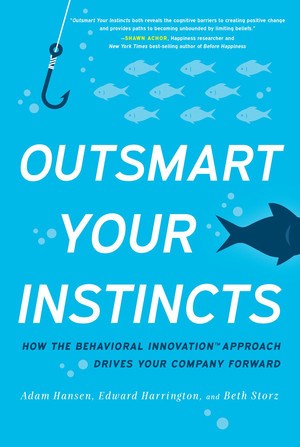Outsmart Your Instincts: How The Behavioral Innovation Approach Drives Your Company Forward
January 30, 2017
The great conceit of Outsmart Your Instincts is applying behavioral economics to the innovation process—to make sure we understand the way our biases get in the way of creativity and how to overcome them.
 We rely on our experience and expertise to compel us forward, but it is often those very qualities that get in the way of us being truly creative, of seeing new solutions to familiar problems, of actually moving forward. New answers and novel ideas usually feel wrong, so we fall back on what we think is the best iteration of the familiar.
We rely on our experience and expertise to compel us forward, but it is often those very qualities that get in the way of us being truly creative, of seeing new solutions to familiar problems, of actually moving forward. New answers and novel ideas usually feel wrong, so we fall back on what we think is the best iteration of the familiar.
But our reliance on experience goes a level deeper than even that, to our gut and instincts, to the way we filter every piece of information in our daily lives, to the nonconscious and automatic ways our brains work. It comes down to the fact that, as the authors of Outsmart Your Instincts succinctly state:
To be human is to have Cognitive Biases.
Those who have tried to make innovation a replicable process or be deliberately creative in the face of any problem know how difficult it can be. And that is because we all have existing biases that trip us up along the way. The great conceit of Outsmart Your Instincts is applying behavioral economics to the innovation process—to make sure we understand the way our biases get in the way of creativity and how to overcome them. Written by three principles of the innovation firm, Ideas to Go, they teach their Behavioral Innovation™ to the reader. In the book, they focus on just eight biases:
- Negativity Bias
- Availability Bias
- Curse of Knowledge
- Status Quo Bias
- Confabulation
- Conformity Bias
- Confirmation Bias
- Framing
Devoting a full chapter to each, they explore the biases in detail and how to negate them in each stage of the innovation process. Because the enemy to innovation, they believe, isn't really in any external process, but within our own brains and biases. And it takes a process to overcome them:
Since we cannot wait for evolution to "catch up" and modify the wiring of our brains, we need to take conscious control of the equipment we have inherited. While we cannot change the wiring (at least not much), we can modify the way the current flows through those archaic connections. This book is about taking control of what has become automatic and using it in a more adaptive and productive manner throughout the creative process of innovation.
And although it will force you to think big, the authors encourage you to start small, to make one small change each day to begin forming new habits and ways of working each and every day. In doing so, they turn innovation from a daunting idea into a denting process for your biggest problems. And, eventually, through small steps and dents, breakthroughs will occur.

